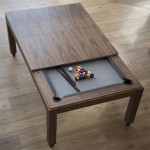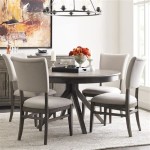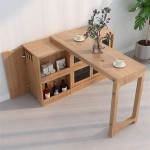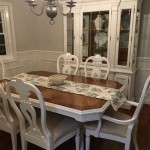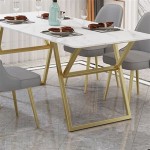The Enduring Appeal of the Gray Wash Dining Room Table
The dining room table serves as a central hub within the home. It's a place for sharing meals, hosting gatherings, and completing everyday tasks. Selecting the right dining table involves considering several factors, including size, shape, material, and style. Among the various finishes available, the gray wash dining room table remains a popular choice due to its versatility and aesthetic appeal. This article will explore the characteristics of gray wash dining room tables, their benefits, and considerations for incorporating them into diverse dining room designs.
The gray wash finish is a technique applied to wood surfaces that imparts a muted, weathered, and often slightly distressed appearance. Unlike a solid gray paint, a gray wash allows the natural grain of the wood to remain visible, contributing to a rustic or farmhouse-inspired aesthetic. The process typically involves applying a diluted gray paint or stain to the wood and then wiping away the excess, leaving a subtle gray tint that highlights the wood's texture and inherent character.
The color gray, in general, is considered a neutral and sophisticated hue. It can act as a calming backdrop, allowing other colors and design elements within the room to stand out. The specific shade of gray used in a gray wash dining table can range from light, almost white-gray, to darker, more charcoal-toned grays, offering flexibility in matching various interior design schemes.
Versatility in Design Styles
One of the primary advantages of a gray wash dining room table is its adaptability to a wide range of design styles. Its neutral color and subtle texture allow it to seamlessly integrate into both modern and traditional settings. In farmhouse or rustic-themed dining rooms, a gray wash table complements wooden chairs, exposed beams, and other natural elements, creating a cohesive and inviting atmosphere. The subtle grain of the wood, enhanced by the gray wash, reinforces the connection to nature.
In more contemporary or minimalist dining rooms, a gray wash table can provide a touch of warmth and texture against sleek, modern furniture and clean lines. The neutral gray helps to soften the overall appearance of the space, preventing it from feeling too stark or sterile. Pairing the table with metal chairs or a glass-top sideboard can create an interesting contrast in materials and textures.
Even in industrial-chic dining rooms, a gray wash table can find its place. It can be paired with metal chairs, exposed brick walls, and industrial lighting fixtures to create an edgy yet comfortable space. The weathered look of the gray wash complements the raw and unfinished aesthetic of the industrial style.
The versatility extends beyond just the overall design style. The accessories and décor used in the dining room can also influence the effectiveness of a gray wash dining table. Using brightly colored placemats, centerpieces, or artwork can add a pop of color to the neutral background, while keeping the accessories in muted tones can create a more understated and sophisticated look. The gray wash finish allows for experimentation with different color palettes and textures without feeling overwhelming.
Highlighting Wood Grain and Texture
The key distinguishing factor of a gray wash finish, compared to a solid paint, is its ability to showcase the natural beauty of the wood grain. Different types of wood will exhibit unique grain patterns, ranging from the straight and subtle grain of maple to the more pronounced and swirling grain of oak. The gray wash accentuates these patterns by settling into the grooves and crevices of the wood, creating a subtle contrast that highlights the wood's inherent character.
This feature is particularly appealing to those who appreciate the warmth and authenticity of natural materials. The tactile experience of wood, combined with the visual interest of the grain pattern, can add a sense of depth and richness to the dining room. The gray wash finish enhances this experience by adding a layer of visual complexity without completely obscuring the natural beauty of the wood.
The level of distressing applied to the wood also contributes to the overall texture and character of the table. Some gray wash tables may feature subtle distressing, such as rounded edges or simulated wormholes, to create a more aged and weathered look. Other tables may have a smoother, more refined finish, allowing the wood grain to be the primary source of texture. The choice of distressing level will depend on the desired aesthetic and the overall design style of the dining room.
When selecting a gray wash dining table, it is important to consider the type of wood used and the specific grain pattern. Some woods may be more suitable for certain design styles than others. For example, a gray wash table made of reclaimed wood with a highly textured grain pattern may be ideal for a rustic or industrial-themed dining room, while a table made of maple with a smoother grain pattern may be better suited for a more contemporary setting.
Practical Considerations and Maintenance
Beyond aesthetics, practical considerations are crucial when choosing a dining room table. The size and shape of the table should be appropriate for the size of the dining room and the number of people who will be using it regularly. A rectangular table is a classic choice that can accommodate a large number of people, while a round or square table may be more suitable for smaller spaces.
The durability of the gray wash finish is another important factor to consider. While gray wash finishes are generally durable, they can be susceptible to scratches and stains if not properly maintained. It is important to protect the table with placemats and coasters to prevent damage from spills and hot dishes. Regular cleaning with a damp cloth can help to remove dust and dirt. Avoid using harsh chemicals or abrasive cleaners, as these can damage the finish.
In some cases, it may be necessary to reapply the gray wash finish over time to maintain its appearance. This is a relatively straightforward process that can be done at home with a few basic supplies. However, it is important to follow the manufacturer's instructions carefully to ensure a consistent and even finish.
The type of wood used in the construction of the table also affects its durability and maintenance requirements. Hardwoods, such as oak and maple, are generally more durable than softwoods, such as pine. However, softwoods can be more affordable and may be a good option for those on a budget. The choice of wood will ultimately depend on the desired balance between durability, cost, and aesthetic appeal.
Consider the base of the table as well. Bases made of wood, metal, or a combination of both are common. Metal bases can offer a more modern look and are often very durable. Wood bases can complement the gray wash tabletop, creating a cohesive and harmonious design. The style of the base can greatly impact the overall aesthetic of the table and should align with the intended design style of the dining room.
Finally, consider the overall budget when selecting a gray wash dining room table. Prices can vary widely depending on the size, material, and construction quality of the table. It is important to set a budget before beginning the search and to compare prices from different retailers to find the best value for money.

What S New Wednesday Grey Wash Dining Table Heather Scott Home Design

Harper Bright Designs Retro Style 6 Piece Gray Wash Wood Rectangle Dining Table Set With 4 Upholstered Chairs And Bench Xw103aae The Home

Benchwright Extending Dining Table Gray Wash 86 122 L Pottery Barn

106 Long Grey Wash Trestle Dining Table Terra Nova Designs

New Arrival Modena Wood Dining Table In Grey Wash

Gray Woven Chairs At Wash Dining Table Transitional Room

Diy Grey Paint Wash Dining Table Chairs The Lighthouse

Pin Page

Gray Wash Dining Table With Side By Benches Cottage Room

7ft Chunky Farmhouse Table With 5 Mixed Grey Winchesters Chairs 1 Fabric Bench Furniture

